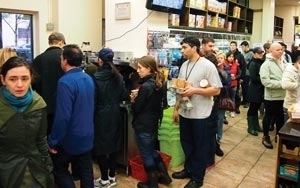 People would rather shop at their local grocery store than anywhere else, but retailers make it tough. Long lines, crowded parking lots and not-helpful help all send them
scampering elsewhere.
People would rather shop at their local grocery store than anywhere else, but retailers make it tough. Long lines, crowded parking lots and not-helpful help all send them
scampering elsewhere.
To win more trips, spending and future loyalty, a new report from consulting company PwC says stores will have to abandon general marketing and merchandising
strategies, and instead tailor stores and regions to more effectively connect with the specific tastes of key sub-segments.
The survey, based on responses from 1,000 U.S. consumers,
reports that 83% prefer shopping at traditional grocery stores, with “close to home” still the major reason they make their selection.
More than half complained about
long lines and crowded stores. It also found that while the vast majority of shoppers -- 92% -- are aware of their ability to buy groceries online, only 1% do so, primarily because they want to see
food before buying it. But that doesn’t mean they aren't enthusiastic about technology, with three of four key segments hoping for more mobile integration from their neighborhood grocer in the
future. While they say they prefer using their own smartphones over, say, a store’s smart kiosk, 80% say they use their phone to access shopping lists, for example.
advertisement
advertisement
PwC says
that four clear distinctions arose among respondents, with the largest group of consumers -- 33% -- falling into what it calls the gourmet category. Most likely to be Gen X or Baby Boomers, 80%
don’t have kids in their home. They are eager for foods that are organic, fresh, good-tasting, and conscientiously sourced. Quality and selection trump price or service.
Next-largest (26%) are what it calls metropolitan shoppers, primarily concerned with convenience. And they are willing to pay for it: It is 40% more important to them that a store is close
than that it has the best prices. They are motivated by getting in and out fast, and are 1.5 times more likely to be vexed by too little parking, for example, and will skip congested aisles. This
group is four times more likely than average to use their devices for everything from lists to recipes to online ordering, and more than half say they hope to be able to use technology to preorder
their food in the near future.
Traditionalists account for 25%, and are the most frugal. They spend the least, and about 25% of this group says they prefer wholesale clubs and
discounters over traditional grocers, because of lower prices. This group dines out the least, spurns most ethnic food options, and is less interested -- even nervous -- about tech offerings. Paper
fliers are still the favorite way to read about sales.
And finally, Millennials account for 17%, and while many are not the primary shopper in their household, are still key
to help grocers build their future. They are most motivated by loyalty programs, most likely to share their shopping experiences online and in social media, and -- big surprise -- crave more tech,
including interactive 3D maps in stores.
“Grocers can no longer rely on providing a one-size-fits-all customer experience. The next wave of millennial consumers is likely to
demand individualized attention and a shopping experience that meets their specific wants and needs,” writes Steven Barr, U.S. retail and consumer practice leader for the consulting firm, in the
report. Stores need to “target customer segments on a micro level to effectively tailor the path to purchase for each shopper when they are in and out of the store. Grocers that truly get to
know their customers on a store-by-store basis can find success in the future.”
"Shoppers waiting in
line to cash" photo from Shutterstock.